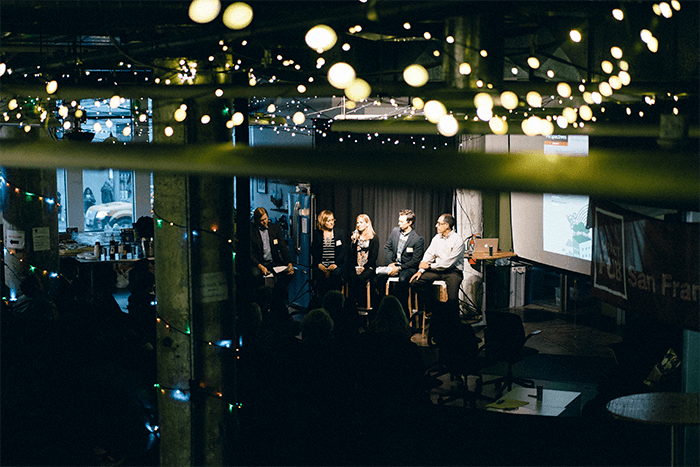
Would you like to join us at our next CSR Perspectives event in San Francisco? Details will be announced this summer but you can register your interest here.
By Tyler Wagner https://player.vimeo.com/video/166072070 On Tuesday, May 3, a great crowd joined us at the Impact Hub in San Francisco for the second installment of #CSRperspectives, a series of interactive audience/panel conversations about the future of corporate responsibility and sustainability. Our discussion this month focused on “Innovating With Purpose,” and looked closely at the ways companies are leveraging sustainability to fuel innovation – both by developing new products and solutions and by looking for innovative ways to address social and environmental challenges. Guided by moderator Jeff Sutton (@JeffGSutton), the discussion flowed freely and included insights from Bruce Klafter (@chicagoBK) of Flex, Jill Stoneberg (@JillStoneberg) of Avaya, Elena Avesani (@Elena_Avesani) of Oracle, and Nick Aster (@NickAster) of TriplePundit. In case you missed it, here are three key takeaways from the discussion:1. Capitalize on customer interest
Avaya’s products include a variety of teleconferencing and cloud offerings. The company’s sales and marketing teams have seen how sustainability is becoming a consideration in customers’ purchasing decisions. Customers are increasingly curious about environmental impacts – and this curiosity does not stop at understanding the footprint of Avaya’s technologies. Customers also want to understand how use of Avaya’s technologies can help them reduce environmental impacts in other areas of their business. That realization on its own isn’t particularly innovative or revolutionary. After all, sustainability has long been a consideration in purchasing or procurement decisions. What is innovative is how Avaya has chosen to act on that information. Avaya’s sales and marketing teams began by reaching out to the sustainability team – including Jill Stoneberg, sustainability manager – to find ways to more meaningfully integrate sustainability into sales and marketing materials. But they did not stop there. Avaya feels so strongly about the value of sustainability for sales and marketing that the company is actually having conversations about the possibility of setting (get ready for this) revenue targets for the sustainability team. Tying sustainability to sales isn’t an easy undertaking, and Avaya is only in the early stages of this discussion. But if the company can pull it off, this kind of innovative thinking would certainly help to take the guesswork out of measuring ROI for sustainability.2. Explore innovative economic models
In the fast-paced world of electronics and hardware, Flex’s business is constantly evolving to meet the needs of customers. Bruce Klafter, Flex’s VP of corporate social and environmental responsibility, talked about the value of innovative economic models (such as the circular economy) that allow for companies like Flex to better serve their customers while also advancing their own sustainability agenda. Customers that rely on suppliers in the early stages of their value-chain – in Flex’s case, for the design and manufacturing of electronic devices and hardware – are increasingly recognizing opportunities for meaningful engagement with those same suppliers at the end of a product’s lifecycle: for recycling and repurposing of parts and products. Suppliers like Flex have intimate knowledge of production processes, materials and (most critically) their alternatives, so they can help customers more fully consider downstream impacts. This puts Flex in a position where it can help customers make choices that increase the utility of their products at end-of-life. This approach helps businesses move from a traditional linear product lifecycle to a circular model. All of this activity grows Flex’s service offering, while enabling the company to make progress toward its own social and environmental goals. It’s a true win for all parties involved, and a great example of innovation driven by sustainability.3) Recognize sustainability as an opportunity for added value
At many companies, sustainability sits somewhere in the middle of the corporate org chart, reporting up through EHS (environmental health and safety), or -- as is often the case with CSR or citizenship teams -- as a function of human resources. But not at Oracle. Elena Avesani, principal strategy manager for sustainability at Oracle, and her counterparts in sustainability are embedded directly in the company’s products and solutions teams. As Elena described, this unique organizational structure is driven in large part by the company’s desire to leverage sustainability as a means to add value to existing products and solutions. In other words, Oracle has recognized that customers interest in sustainability represents a significant business opportunity. In some cases, these opportunities are identified by customers themselves. Customers have asked Oracle to bake additional functionality into its enterprise software – such as the ability to better manage data on energy use, water, emissions, etc. In other cases, Oracle’s internal teams identify opportunities and then enlist internal departments or teams for pilot projects before flipping the switch and offering additional functionality to customers. In either case, Oracle has recognized that, by integrating this kind of functionality into the platforms and applications that its customers already use, the company can increase the value of those applications to its users. Such features add value and differentiate Oracle’s product offering from competitors.Opportunities to innovate are everywhere
The consensus among the group was clear: Interest in sustainability extends far beyond the sustainability team – and interest is growing. With this interest come opportunity – not only to develop new products, solutions and technologies, but also to challenge traditional business models and change the way we measure sustainability’s value. How is sustainability driving innovation at your company? Let us know in the comments, and we hope to see you at our next #CSRperspectives event. Images and video courtesy of thinkPARALLAX Tyler Wagner is an Account Strategist at thinkPARALLAX, a sustainability communications consultancy dedicated to building brands with purpose. Would you like to join us at our next CSR Perspectives event in San Francisco? Details will be announced this summer but you can register your interest here.TriplePundit has published articles from over 1000 contributors. If you'd like to be a guest author, please get in touch!














